Ground floor ventilation: general arrangement technology + effective air exchange methods
Properly equipped ventilation of the basement, during the operation of the latter, relieves people from contact with dampness, mold, a number of other pathogens and gases. Therefore, it is possible to ignore the presence of a hood only in exceptional cases.
It is important to understand that the creation of such a system requires certain knowledge and skills, even if specialists are involved in the work.
Let's look at the ventilation methods and the intricacies of its arrangement together.
The content of the article:
Popular ventilation methods
The relevant guidance documents and practice show that basement floors can be effectively ventilated in several ways: naturally and forcibly.
In addition, today a mixed or complex method of arranging an exhaust system is used more and more often - having the characteristic features of both of the above options.
And also when using mixed ventilation, additional equipment is used.

Based on the listed methods, all the ventilation schemes demanded today have been created, so you should familiarize yourself with each of them. But first, we will analyze the general technology for arranging the ventilation of the basement.
Technology for creating a ventilation system
Although there are several varieties of basement ventilation systems, there is no variety of schemes and technologies. The basis of any hood is a natural supply and exhaust air exchange.
The arrangement of any method is similar.That is, it all starts with the planning and placement of products, ventilation pipes.
If the area of the room is large (over 50 m²), then a fan of sufficient power should be added to the structure. In this case, the inlet openings must provide a supply of clean air.
If there are several rooms and in each of them it is necessary to maintain a separate microclimate, then it will be necessary to create complex ventilation systems.
Which involve the use of natural or forced draft in separate rooms, and for its implementation a large number of additional equipment can be used.
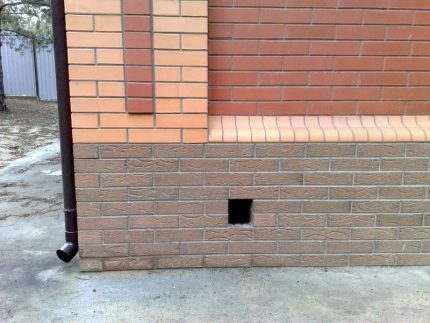
The most important point is the number of ventilation holes. If they are lacking, the system will not be able to cope with the task even in a small basement.
Since numerous stagnant zones with increased humidity and other negative phenomena will form.
This indicates that there should be a lot of ducts, and their exact parameters are indicated by the profile Code of rules - SP 54.13330.2011. Where it is clearly noted that the total area of ventilation openings should be 1/400 of the entire area of the basement.
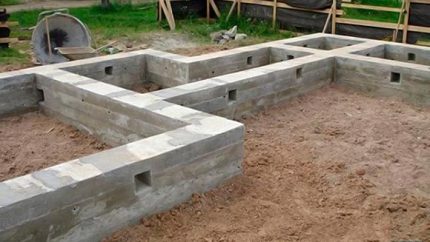
The same document says that these elements should be evenly spaced around the perimeter. Another rule contained in the joint venture is to indicate the exact value of the area of each duct, which should not be less than 0.05 m².
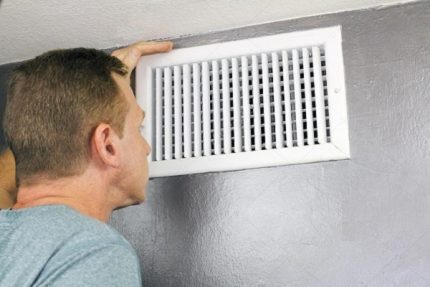
And then, to determine the parameters and draw up a ventilation scheme, it remains only to perform a simple calculation.
Why do you need:
- The area of the basement is divided by 400. The result is the total area of the holes in the basement;
- The resulting value should be divided into 2 (pairs of supply and exhaust structures) and place them evenly around the entire perimeter of the building.
It should be remembered that according to the joint venture it is not necessary to make a round hole with a diameter smaller than 25 cm, and the minimum size of rectangular ones should be 20 × 22 cm.
An exception may be situations when several smaller ducts are placed side by side - if round ducts are made, their diameter may not be 25 cm, but 11 cm.
Do not make the ventilation openings as large and rare as possible. For example, in a house, the ground floor area of which is 100 m² with the intended air volume of 250 cm², they should not be divided between 4 large ones, as many developers do, but divided into 10 small ones.
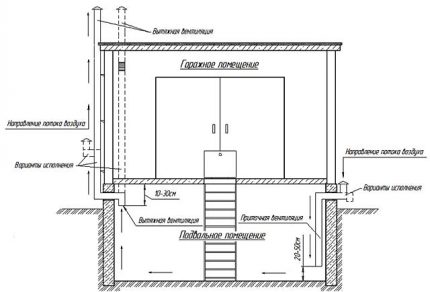
And it’s even more practical to make two dozen of the minimum allowable holes, for example, round with a diameter of 11 cm and place them every about one and a half meters around the entire perimeter.And such a ventilation scheme for any basement floor will be as efficient and profitable as possible.
If the air ducts cannot cope with the function of replacing the air in the basement room, then air ducts are added to the ventilation system - pipes, which are additionally equipped with fans and other additional equipment characteristic of the forced system.
Features of natural air exchange
As the name suggests, this ventilation method is based on the laws of physics, so the use of any special equipment is not intended.
Air exchange is due to temperature differences inside the basement and outside, as well as the subsequent differential pressure following this phenomenon.
System Organization Procedure
To ensure effective air exchange, a number of operations should be performed, and in the following order:
- To calculate the area of ducts. It is optimal to carry out such a procedure at the design stage of the entire building. If mistakes are made, then adjustments can be made even after the facility is commissioned.
- Calculate the number of exhaust openings and determine their location. Which is also performed at the design stage.
- Form products. Since the effectiveness of the entire system, as well as the aesthetic properties of the socle, depend on this operation, this issue will be considered separately.
- Install in the resulting holes deflectors or just close them protective grilles. Which prevent the entry into the premises of animals, objects.
- To test the formed system. What can be done with a burning candle.
In addition, if necessary, you can perform work on decorating the resulting ducts.
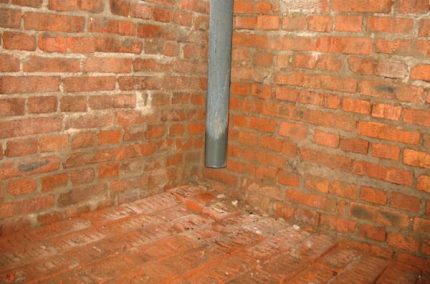
If the performance of the ventilation openings (vents) is not enough, then the following should be done:
- Use exhaust pipes for air exchange.
- Install the supply pipe at a level of 20-40 cm from the floor level of the basement.
- Place an exhaust pipe opposite the supply pipe, that is, in the opposite wall of the room.
The exhaust vent should be as close to the ceiling as possible, and if possible, right in it. And it should go over the roof, about 0.6 m above the roof.
Regardless of which way to place the air ducts is chosen, remember that there should be no unventilated corners. To avoid such a flaw, the nearest ventilation hole should be located no further than a meter from the specified location.
But often, experts recommend using the standard that is used in many European countries and placing the first duct from the corner no further than 90 cm, which is more likely to prevent the occurrence of negative processes on the basement.
How to shape the holes?
There are no requirements for the configuration of the holes, that is, they can be made of any shape, even triangular, which is now in fashion.
But the most popular are:
- square;
- rectangular.
They are easily formed. To perform this operation, it is enough to use 4 boards of the right size, from which a geometric shape of the desired shape is simply built and installed in the right place, after which it is laid out with a mortar, brick.
Holes of other shapes are made in a similar way, for example, the triangles that are increasingly popular today.
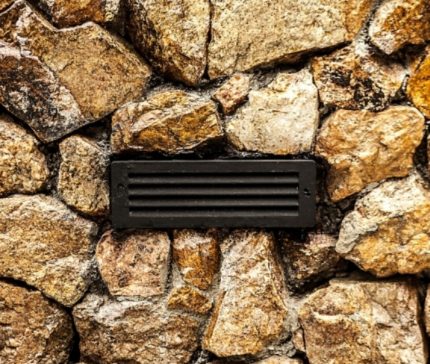
But more and more often you can find their round counterparts, which are easily created with the help of a plastic tube of the desired diameter (often 110 mm) and a length that should be equal to the thickness of the base and foundation.
It is simply placed in the right place and surrounded with a solution. The result is perfectly even holes.
If ventilation products were not made when creating the basement, then they are created using diamond drilling. As a result, they also turn round.
Important system features
The number of exhaust openings plays an important role, but when creating them you should always remember that their location is no less important feature, significantly affecting the efficiency of the entire ventilation system.
So, pairs of input and output ducts should be placed strictly opposite each other.
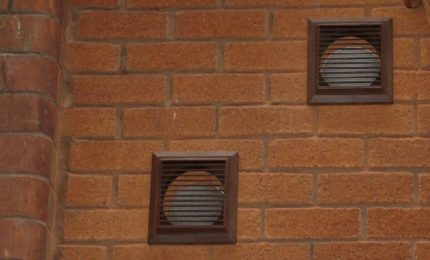
And also you need to know that:
- Exhaust openings should be located at least 40-60 cm from the ground. Which will reduce the likelihood of clogging them with snow, which should not be allowed, since the efficiency of removal of polluted air masses will decrease or the process will stop altogether.
- Since natural ventilation operates on the principle of temperature and pressure differences, the exhaust pipe from the base can be brought out onto the street, stretching the highway through all floors. What will make the system more expensive, but also as efficient as possible. It is placed 30-60 cm from the roof, as this eliminates the likelihood of snow falling into the duct.
All inlet / outlet channels must be protected by gratings that will prevent rodents, pets, birds, insects from getting inside.
If a similar temperature has been established on the basement and the functioning of the natural hood has been suspended, then a heater or any other heating device should be installed in the room. That will help to quickly create the necessary conditions for the resumption of air exchange.
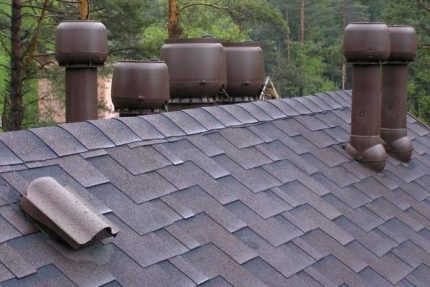
Natural extract shows the best properties while maintaining the microclimate in small rooms. Therefore, if the basement floor area exceeds 50 m², then you should not risk it and use a forced air exchange system or a mixed version.
Otherwise, the maximum effect can not be achieved, which will lead to negative processes.
Subtleties of the forced draft device
This kind of ventilation system is structurally similar to the natural one described above. But they are made different by the presence of fans and other additional equipment, which increases, and dramatically, the efficiency of the hood in the basement.
Forced ventilation is considered an expensive way to eliminate contaminated air masses.
And yet, such a drawback is offset by the lack of dependence on natural conditions, the complex configuration of the basement floor, and the mistakes made when creating a natural hood. That is, from everything that makes the system ineffective.
It’s quite simple to equip the simplest forced hood - just install it in the exhaust duct duct fan.

If the basement is divided into several rooms, and everything needs to be ventilated, then there will be few exhaust equipment in one room.
As a result, you will have to get out of the situation in the following ways:
- the creation of air channels laid under the ceiling in all the necessary rooms, which are formed of metal or plastic pipes;
- installation of exhaust and supply fans.
Supply fans will help solve the problem in particularly difficult conditions. Usually they are used exclusively in conjunction with exhaust.
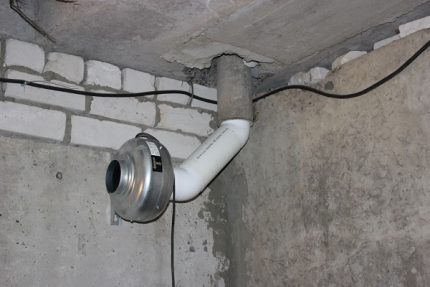
Since the fan is the basis of high-quality ventilation of any forced system, you should familiarize yourself with the technology of its selection. Since not every product will cope with the task, and many will even pose a danger to the life and health of users.
Necessary equipment for assembling the system
To ensure forced drawing, the following may be used:
- fans
- humidity sensors, their more obsolete counterparts, which are hygrometers.
- Thermostats
- heaters.
Most often, fans are used to obtain the desired result. The most important characteristic of such equipment is productivity and it will have to be calculated in each specific case.
But to do this is not difficult, since all that is needed is to use a special formula for calculation. According to which the optimal fan power is the derivative of the building volume of the desired room and the multiplicity of the amount of exchange of air volumes for each hour.

ventilation is the most important performance characteristic on which efficiency depends. And if it is not enough, then forced air exchange is likened to ordinary natural. In addition, such a product must be safe, and if the base is inhabited, then noiseless
In addition, the important operating characteristics of any exhaust fan are: safety, noiselessness, functionality. It is advisable to use a waterproof device.
Humidity sensors allow you to generate a signal to turn on / off the equipment used. For example, the same fans. That will eliminate dampness, and without overpaying for electricity. After all, ventilation devices will work in situations where this is necessary.
Thermostats are designed to keep the basement temperature stable. Serve for supplying a command signal to turn on / off the air heater and other equipment used to heat the supply air.
That allows not only to maintain a given temperature regime, but also to create a pressure drop to ensure the desired ventilation system performance without fans.
Stages of installation of the forced system
Arrangement of a forced ventilation system is performed in several stages.
Which include:
- Calculation of the area of vents, their quantity. These operations are similar to those performed during the design of natural hoods (listed above).
- Calculation of fan performance.
- Creating air ducts in compliance with the requirements specified for natural extraction.
- Installation of fans and optional equipment if necessary.
- Health Check.
All calculations are made at the design stage of the basement.
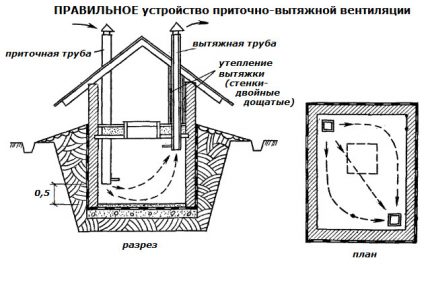
Mixed and complex ventilation systems
Mixed systems are among the most productive, since they take into account the particular conditions in each specific situation. They are based on the conventional natural draft scheme described above, while modern optional equipment adds to the efficiency.
Any scheme of a mixed or complex ventilation system implies the presence of a large number of structural elements, equipment.
In this case, typical solutions are not a way out. Since it is necessary to perform large volumes of calculations in each case.
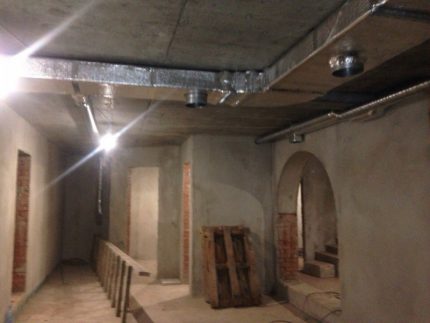
Such systems are useful when the ventilation system in separate rooms of the basement needs to create different conditions.
For example, if a pantry, a gym and a wine cellar are located underground. In the storage place of something, you can take advantage of natural ventilation; for efficient air exchange in the training room, instead of exhaust air, an exhaust fan should be installed.
And where wine is stored, which needs a special regime, in addition to all of the above, it is necessary to use a number of additional equipment. Which will help keep the microclimate stable.
In a room with wine racks will be required check valves, which exclude the ingress of external air into the room, air conditioners, control systems, etc.
The exact scheme of mixed or complex systems is created in each case, taking into account the needs. When arranging, the same technologies and schemes should be used as when creating hoods of other types.
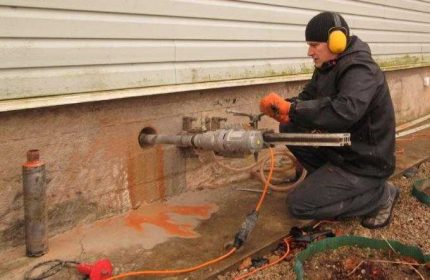
For example, if the basement is divided into several rooms, then it should be remembered that adjacent walls are an obstacle to the movement of air masses. As a result, the creation of vents, ducts, channels is required.
On our site there are several more articles where we spoke in detail about the arrangement of ventilation in various rooms. Recommended reading:
- Garage ventilation.
- Organization of ventilation of the cellar.
- Arrangement of ventilation of the steam room.
- Pool ventilation.
- Arrangement of a basement ventilation system.
Conclusions and useful video on the topic
The video will allow you to deepen your knowledge on arranging the ventilation of the base and creating holes with diamond cutting, which will help to avoid mistakes that lead to financial losses.
An example of working ventilation in the basement of a private house:
Although there are several varieties of hoods, ventilation in the basement is a natural way. Which provides an effective exchange of air masses for a socle with an area of up to 50 m2.
If its dimensions of the basement are more than the specified value or the area is divided into several rooms, then the effectiveness of natural extraction will be insufficient.
In such situations, modern equipment will be needed to organize a forced ventilation system with the arrangement of ventilation ducts equipped with fans to accelerate the process of supplying fresh air instead of remote for each of the basement rooms.
Do you have personal experience in arranging a basement ventilation system? You can share your own experience or ask questions about the topic of the article in the block below.

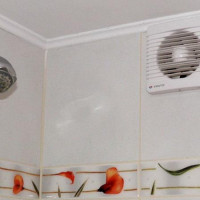 Is forced ventilation in the bathroom necessary: norms and stages of arranging efficient air exchange
Is forced ventilation in the bathroom necessary: norms and stages of arranging efficient air exchange  Basement ventilation in a private house: the best ways to arrange proper air exchange
Basement ventilation in a private house: the best ways to arrange proper air exchange 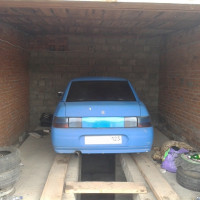 Inspection pit ventilation in a garage: specifics of arranging an air exchange system
Inspection pit ventilation in a garage: specifics of arranging an air exchange system 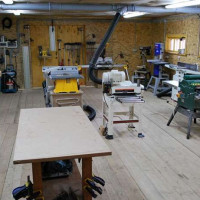 DIY ventilation in the workshop: options and principles for arranging an air exchange system
DIY ventilation in the workshop: options and principles for arranging an air exchange system 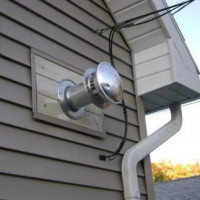 How the hood in the garage is arranged: popular schemes and technology for proper arrangement
How the hood in the garage is arranged: popular schemes and technology for proper arrangement 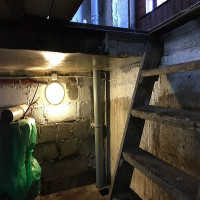 Ventilation of a vegetable pit in a garage: organization of air exchange in a garage vegetable store
Ventilation of a vegetable pit in a garage: organization of air exchange in a garage vegetable store  How much does it cost to connect gas to a private house: the price of organizing gas supply
How much does it cost to connect gas to a private house: the price of organizing gas supply  The best washing machines with dryer: model rating and customer tips
The best washing machines with dryer: model rating and customer tips  What is the color temperature of light and the nuances of choosing the temperature of the lamps to suit your needs
What is the color temperature of light and the nuances of choosing the temperature of the lamps to suit your needs  Replacement of a geyser in an apartment: replacement paperwork + basic norms and requirements
Replacement of a geyser in an apartment: replacement paperwork + basic norms and requirements
Last summer, I built a garage with a full basement on my personal plot. Apparently, the builders incorrectly designed the ventilation system, and now, when the period of snowmelt has begun, a steady smell of dampness has appeared in the basement. I carefully examined all the walls and floor, but did not find any moisture or mold. I think that the problem is an insufficient number of exhaust vents (only one). Now I don’t know what to do? To drill additional holes, put the forced ventilation system in an existing outlet or do several air hatches in the floor of the first floor?
Is it really ventilation? If this is the case, then making additional vents will not be difficult. Ideally, of course, it is better to attract those specialists who were engaged in these works for you, so that they correct their own miscalculations.
But it may be that there are problems with waterproofing. That is why in the basement there is a smell of dampness. Then you will have to try to eliminate such a more serious problem. Could you take a few photos or at least lay out an approximate floor plan so that you can see the size, as well as the location of the vents.
And yet, you did not check the outlets themselves? They simply could get clogged, therefore the ventilation system in the room was broken.
At the expense of forced ventilation, think last of all if there are no problems with waterproofing and there are no blockages in the existing vents.